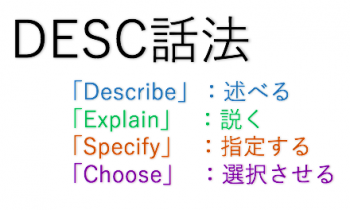How to make suggestions easier DESC’s way of speaking
Is there a way to talk through suggestions?
Is the proposal really transmitted to the other party?
For this time, I would like to talk about the way of talking to “proposal” “DESC talking law”.
What is DESC talking

DESC talking stands for “Describe” “Explain” “Specify” “Choose”.
These are “Explain” → “Express” “Specify” → “Suggest” “Choose” → “Consequence”
It may change to. The content is the same.
As a way of speaking it is below.
“Describe”: depiction (current situation)
“Explain” “Express”: to preach, to express (sympathize)
“Specify” “Suggest”: Specific presentation, suggestion (to suggest)
“Choose” “Consequence”: selection, conclusion (to conclude)
It can be used as a method to tell the other party “proposal” “request”.
It is of great use even in negotiating scenes.
There are advantages and disadvantages, and it will be as follows.
merit
Explanation contents are conveyed concisely and clearly
The other party is easy to understand the situation (easy to feel)
You can respect the opinions of the opponent
Proposal / alternative plan is easy to pass
It tends to be constructive discussion
disadvantage
I can not push my opinion hard
We need to have multiple proposals
The right of selection and decision becomes opponent
Responsibilities become partners
Therefore, it becomes a perfect way of speaking for “suggestions” of things.
Use it when you want to tell the other party ‘Request’, or when you want to leave it to the other party’s judgment.
Anybody who is a member of society thinks that we must “request”, “suggest” and “negotiate”.
For me, I would like to be able to use it in various situations together with “PREP Speech” .
DESC talking method can propose suggestions and requests in various scenes
Let’s propose a great deal of time, let’s grasp the opportunity firmly.
This book is a book detailing how to talk about opportunities.
チャンスを生かせる人の話し方
Talking way to convey the proposal briefly and clearly
· Example of how to use (without DESC speech)

If it is bad at suggesting it might be as follows.
Salesman “Chief, I would like to have one person attached.”
Section chief “Why do you want to put on a single person?”
Salesman “It is because there are plenty of counterparts in charge.”
Section manager “Everyone is busy.”
Salesman “Although it seems that sales are increasing in XXX district.”
Chief “So? It’s just speculation, is not she?”
Section Chief: “What are you saying, do not make your district satisfied, too?”
…
It will be disappointing.
Although I make a proposal, I am only interfering with my boss’ s job.
Salespeople are not bad, but this is also likely to be said from the boss (section chief) “Do more firmly!”
Even if there is good information, I will miss the opportunity depending on how you speak.
· Example of usage (DESC talking method)

If it is DESC talking it will be as follows.
Salesman “Chief, the percentage of 7% products purchased in XXX district in the past three months is increasing.”
Salesman “If I can, I would like to respond, but I am full of requests from the district concerned.”
Salesman “I’d like to have a salesperson alone.”
Section chief “I can not handle it now …”
Salesman “If so, how about letting those who failed to meet their business goals be awarded only three days a week and trying to meet their business goals?”
Section manager “OK, let’s do it!”
Here I will break down the way of talking now and explain.
“Describe”: depiction (current situation)
→ “The section manager, the percentage of 7% products purchased in the XXX district is increasing in the past three months.”
Here, it is a problem situation for the proposal that “7% products are increasing in the XXX area in the past 3 months”.
The important thing in the way of speaking is to “speak the problem situation objectively to the current proposal”.
“Explain” “Express”: to preach, to express (sympathize)
→ “I would like to respond if possible, but I am full of requests from the district concerned.”
Here, “I want to do” → “You can not do it” will talk about your feelings.
The boss (section chief) can also draw out the feelings of the salesperson from the situation that you can understand the back of the word (actions you have done so far).
What is important in the manner of speaking is “to feel empathy, to talk about their feelings and empathy.
However, I will not do anything to impose my own opinion.
“Specify” “Suggest”: Specific presentation, suggestion (to suggest)
→ “I’d like to have one salesperson on hand.”
Here, “to put one salesman on” is a “request” and will be “a proposal”.
What is important in the manner of speaking is “to talk about content that can be concretely realized, content that can improve the problem”.
Even if the partner is involved in the problem, I will not speak to the other party.
“Choose” “Consequence”: selection, conclusion (conclude, connect)
→ A salesperson took an alternative plan in the case of “No” taking “No” as the section manager “Now that there are no hands” … = No.
The alternative was “to add people only three days a week” or “to make it an opportunity to achieve business goals”. That will be “connected” content.
What is important in the way of speaking is “to suggest the next proposal or action to be taken regardless of whether the proposal is Yes or No”.
Let the other party tell the selection result or conclusion.
It is one of the ways to make proposals easier to have some suggestions and chosen first.
Also, bringing “what you really wanted to do” as an alternative proposal is one way to pass higher requests.
If you use the DESC speech method, you can talk proposing constructively based on the partner’s idea
Question how to make the other party easier to talk and make it easier to deepen your talk than
As mentioned earlier, as a way to make the proposal easier, I told you to “have the proposal picked up.”
The reason is because people are easy to answer “limited questions”.
Therefore, when you want to listen closely, “limited question” → “expanded question” becomes.
Although I derail a bit, I think that I will explain it because it is important content.
I will talk about the difference between “limited question” and “expanded question”.
· Limited questions
It will be a fixed question with specific answers such as “Yes” “No”, “Yes” “No”.
Easy to reply, you can know the question briefly. In the case of
· Enlarged question
It is a way of talking about “what” “like” “5W1H”, “how” “and so on.
It takes time to respond because we have to think about it. You can know the idea of the partner in detail in detail.
Inquire deeply the idea of the opponent by changing from the limited question to the expanded question
Let’s propose a great deal of time, let’s grasp the opportunity firmly.

